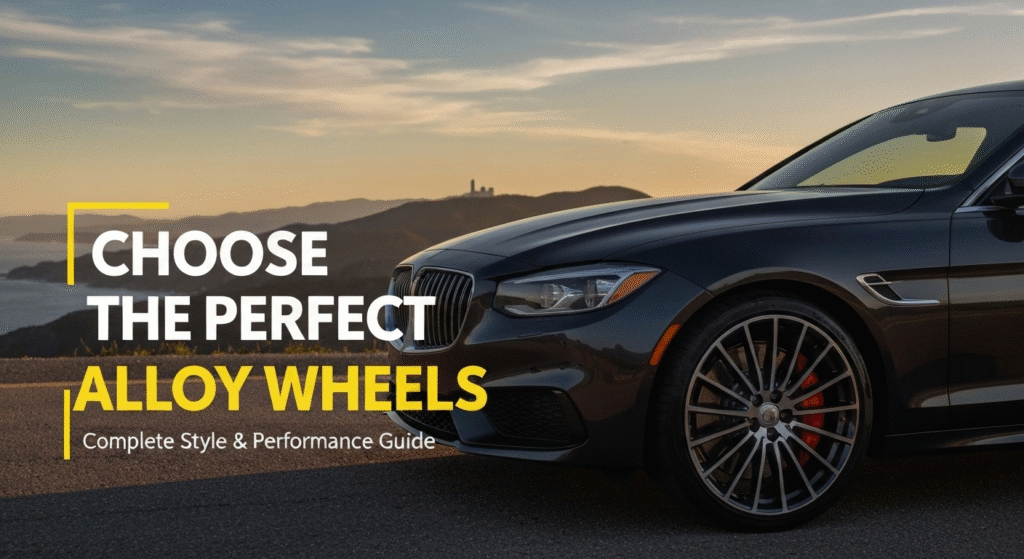Alloy wheels can completely change how your car looks and performs. After working with thousands of car enthusiasts over the past five years, I’ve seen how the right wheel choice transforms both appearance and driving experience. My name is Sharmin, and I’ve been helping drivers select perfect alloy wheels since 2019. Through my work as an automotive consultant, I’ve guided everyone from first-time buyers to luxury car collectors in making informed wheel decisions.
The right alloy wheels do more than just look good. They reduce weight, improve handling, and can even boost fuel efficiency. But choosing wrong? You’ll face poor performance, expensive repairs, and a car that doesn’t reflect your style.
What Are Alloy Wheels and Why They Matter
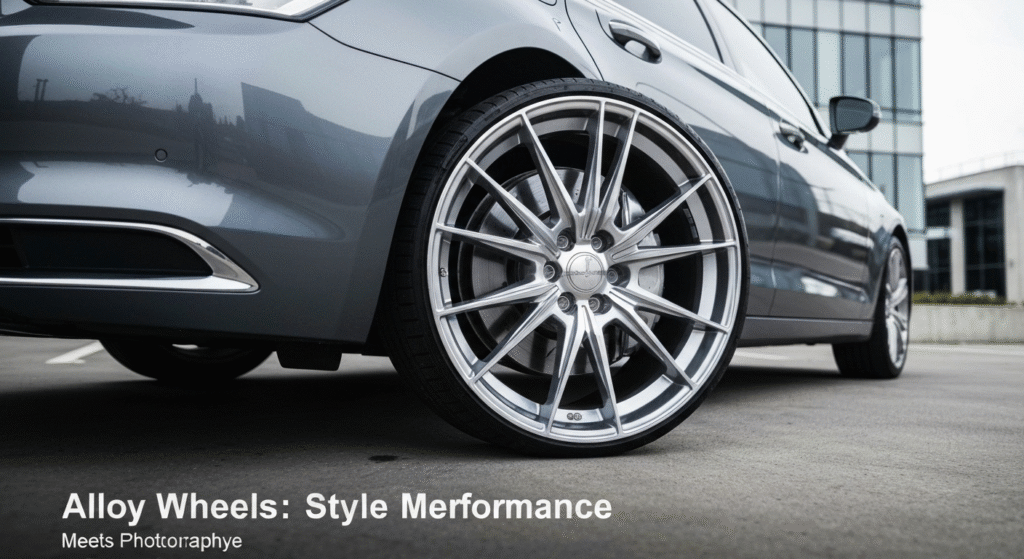
Alloy wheels combine aluminum with other metals like magnesium or nickel. This creates a lighter, stronger wheel than traditional steel options. The manufacturing process allows for complex designs that steel wheels simply can’t achieve.
I remember when my first client, Sarah, upgraded from basic steel wheels to quality alloys on her Honda Civic. The transformation was immediate. Her car looked sportier, handled better in corners, and she noticed improved acceleration. That’s the power of choosing right.
Key Benefits of Alloy Wheels
| Benefit | Steel Wheels | Alloy Wheels |
|---|---|---|
| Weight | Heavy (reduces performance) | Light (improves handling) |
| Heat Dissipation | Poor | Excellent |
| Design Options | Limited | Unlimited |
| Corrosion Resistance | Prone to rust | Highly resistant |
| Cost | Lower upfront | Higher initial, better long-term value |
Understanding Your Car’s Wheel Requirements
Before you fall in love with any design, you need to know your car’s specifications. This prevents costly mistakes and ensures optimal performance.
Critical Measurements You Must Know
Wheel Size: Your car’s manual lists the recommended diameter, usually between 15-22 inches. Going larger looks sportier but can hurt ride comfort. I typically recommend staying within 1-2 inches of the original size.
Bolt Pattern: This determines which wheels fit your car. Common patterns include 4×100, 5×114.3, and 5×120. Getting this wrong means the wheel won’t mount properly.
Offset: This affects how the wheel sits in the wheel well. Incorrect offset can cause rubbing against the fender or suspension components.
Load Rating and Speed Rating
Every wheel has weight limits and speed capabilities. Exceeding these creates dangerous driving conditions. I’ve seen wheels crack under excessive load, leading to dangerous blowouts.
The load rating appears as a number (like 1200 lbs per wheel). The speed rating uses letters (H = 130 mph, V = 149 mph). Match or exceed your car’s requirements.
Different Types of Alloy Wheels
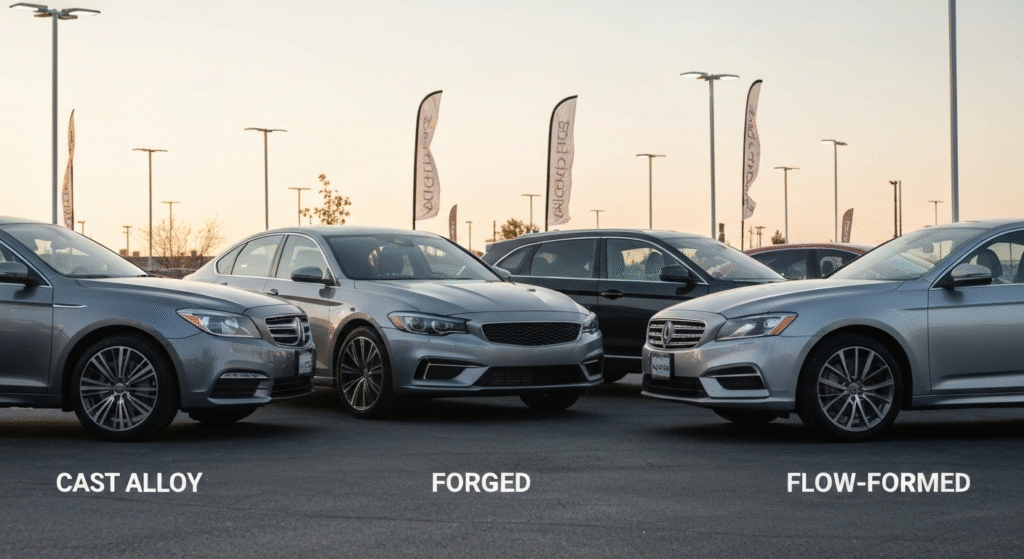
Understanding construction methods helps you choose wheels that match your priorities and budget.
Cast Alloy Wheels
Cast wheels use molten aluminum poured into molds. This creates affordable options with good strength for daily driving. Most factory wheels use this method.
Pros:
- Affordable pricing
- Wide variety of designs
- Good for daily driving
- Easy to repair if damaged
Cons:
- Heavier than other types
- Less precise manufacturing
- Limited strength for extreme use
Forged Alloy Wheels
Forged wheels start with solid aluminum blocks shaped under extreme pressure. This creates incredibly strong, lightweight wheels preferred by performance enthusiasts.
During my years in the industry, I’ve noticed forged wheels consistently outperform cast options in durability tests. They’re worth the investment for serious drivers.
Pros:
- Exceptional strength-to-weight ratio
- Superior performance characteristics
- Long-term durability
- Premium appearance
Cons:
- High cost
- Limited design options
- Longer production times
Flow-Formed Wheels
Flow-forming combines casting and forging techniques. The rim gets stretched and compressed while spinning, creating strength similar to forged wheels at lower costs.
Choosing Wheels Based on Your Car’s Style
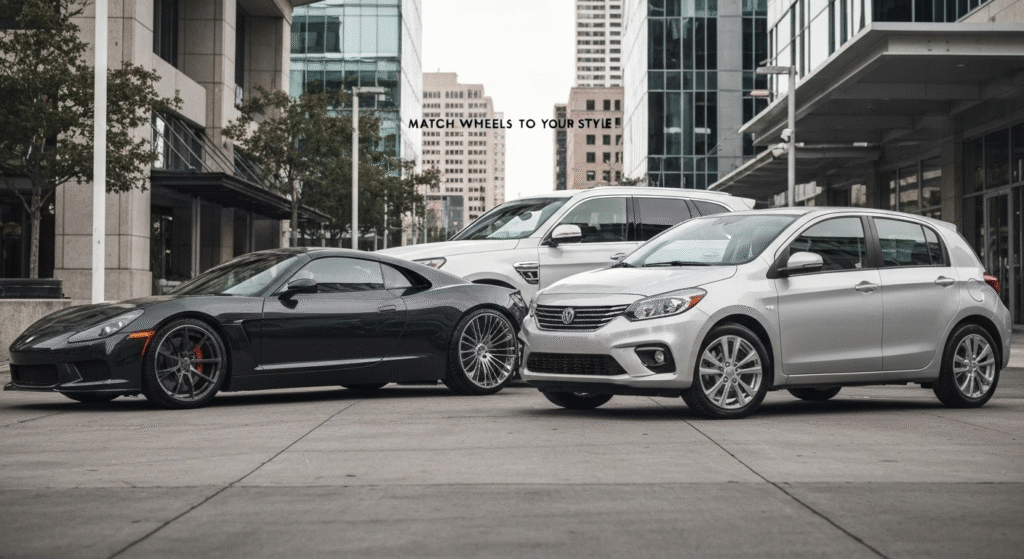
Your car’s design language should guide wheel selection. Mismatched wheels can ruin even the most beautiful vehicle.
Sports Cars and Performance Vehicles
Sports cars need wheels that complement their aggressive styling. Larger diameters (18-20 inches) with low-profile tires create the right proportions.
Recommended Styles:
- Multi-spoke designs for airflow
- Concave profiles for depth
- Darker finishes (gunmetal, black)
- Wider widths for better handling
I worked with a Mustang owner who chose 19-inch concave wheels in matte black. The transformation turned his car from ordinary to extraordinary, while the wider stance improved cornering performance.
Luxury Sedans and SUVs
Luxury vehicles demand elegant, sophisticated wheel designs. Clean lines and premium finishes maintain the upscale appearance.
Ideal Characteristics:
- Classic spoke patterns
- Polished or chrome finishes
- Larger diameters (19-22 inches)
- Subtle design details
Compact Cars and Daily Drivers
Smaller vehicles need wheels that enhance without overwhelming. Focus on lightweight options that improve efficiency.
Best Practices:
- Stay close to original diameter
- Choose lighter designs
- Consider aerodynamic patterns
- Balance style with practicality
Color and Finish Options Explained
Wheel finish dramatically affects your car’s overall appearance. Each option offers different benefits and maintenance requirements.
Popular Finish Comparisons
| Finish Type | Appearance | Maintenance | Durability | Best For |
|---|---|---|---|---|
| Silver/Machined | Classic, versatile | Easy | Good | All vehicle types |
| Black/Dark | Sporty, aggressive | Moderate | Excellent | Performance cars |
| Chrome | Luxury, eye-catching | High | Poor | Luxury vehicles |
| Bronze/Gold | Unique, warm | Moderate | Good | Sports cars, JDM style |
Matching Finishes to Car Colors
White Cars: Nearly any finish works, but black creates striking contrast while silver maintains elegance.
Black Cars: Lighter finishes like silver or machined faces prevent the “lost” look, while black-on-black creates stealth appeal.
Silver Cars: Avoid similar silver finishes that disappear. Choose darker or brighter options for definition.
Red Cars: Black, gunmetal, or bronze complement red paint beautifully. Avoid chrome or bright silver.
Sizing Considerations for Optimal Performance
Wheel size affects every aspect of your driving experience. Bigger isn’t always better.
The Plus Sizing Concept
Plus sizing maintains overall diameter while changing wheel and tire proportions:
- Plus 1: 1-inch larger wheel, shorter sidewall
- Plus 2: 2-inches larger wheel, much shorter sidewall
Performance vs. Comfort Trade-offs
Larger Wheels (19+ inches):
- Better handling and braking
- Improved appearance
- Reduced ride comfort
- Higher replacement costs
- More susceptible to damage
Smaller Wheels (15-17 inches):
- Better ride quality
- Lower costs
- Better fuel economy
- Less visual impact
- Reduced performance
From my experience helping clients, most drivers are happiest with plus-one sizing. It provides noticeable improvements without major compromises.
Budget Considerations and Value
Alloy wheel prices vary enormously. Understanding what drives costs helps you make smart decisions.
Price Range Breakdown
Budget Options ($100-300 per wheel):
- Cast construction
- Basic finishes
- Limited warranty
- Good for daily drivers
Mid-Range ($300-800 per wheel):
- Better manufacturing quality
- More finish options
- Longer warranties
- Suitable for most applications
Premium ($800+ per wheel):
- Forged or flow-formed construction
- Custom finishes available
- Extensive warranties
- Performance-focused features
Long-term Value Factors
Quality wheels last longer and maintain appearance better. I’ve seen cheap wheels corrode, crack, or lose finish within two years. Premium wheels often look new after five years with basic care.
Consider These Value Factors:
- Warranty coverage length
- Finish durability
- Brand reputation for service
- Availability of replacement parts
Installation and Maintenance Tips
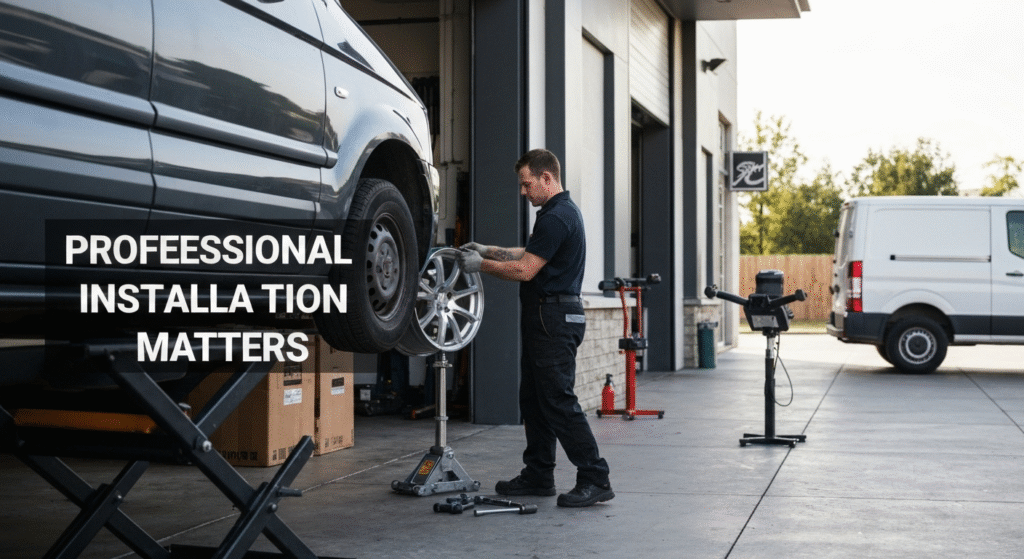
Proper installation and care extend wheel life significantly. Poor installation can damage wheels or create safety hazards.
Professional Installation Benefits
Professional installers have proper equipment and experience. They’ll:
- Balance wheels correctly
- Torque lug nuts to specification
- Check for clearance issues
- Verify proper fitment
Maintenance Best Practices
Weekly Care:
- Rinse wheels with clean water
- Remove brake dust promptly
- Check for damage or loose lug nuts
Monthly Deep Cleaning:
- Use wheel-specific cleaners
- Apply protective coatings
- Inspect for cracks or bends
- Check tire pressure
Seasonal Tasks:
- Rotate wheels and tires
- Professional balancing check
- Torque specification verification
Common Mistakes to Avoid
Through years of helping customers, I’ve seen the same mistakes repeatedly. Avoiding these saves money and frustration.
Sizing Errors
Going Too Large: Many clients want maximum visual impact but regret the harsh ride and expensive tire replacements.
Ignoring Load Ratings: Undersized load ratings create dangerous conditions, especially for SUVs and trucks.
Wrong Offset: Incorrect offset causes rubbing, premature wear, and handling problems.
Style Mismatches
Following Trends Over Function: What looks good on social media might not suit your specific vehicle or driving needs.
Ignoring Vehicle Proportions: Oversized wheels on compact cars look awkward and hurt performance.
Budget Shortcuts
Choosing Price Over Quality: Cheap wheels often cost more long-term through replacements and repairs.
Skipping Professional Installation: DIY installation mistakes can damage wheels or create safety hazards.
Frequently Asked Questions
Q: Can I use different size wheels on front and rear? A: Only if your car came with staggered fitment from the factory. Most vehicles need identical wheels for proper handling and tire rotation.
Q: Do alloy wheels improve fuel economy? A: Yes, lighter alloy wheels reduce unsprung weight, which can improve fuel economy by 1-3%. The improvement is more noticeable with larger size differences.
Q: How often should I replace alloy wheels? A: Quality alloy wheels can last 10+ years with proper care. Replace them if you notice cracks, severe corrosion, or structural damage.
Q: Are expensive wheels worth the cost? A: For daily drivers, mid-range wheels offer the best value. Premium wheels are worth it for performance applications or if you plan to keep the car long-term.
Conclusion
Choosing the right alloy wheels transforms your car’s appearance and performance. Focus on proper fitment first, then select styles that complement your vehicle’s design. Quality wheels from reputable manufacturers provide better long-term value than budget options.
Consider your driving needs, maintenance preferences, and budget carefully. When in doubt, consult with professionals who can guide you toward wheels that deliver the perfect balance of style, performance, and value for your specific situation.
The right wheels make every drive more enjoyable while expressing your personal style. Take time to choose wisely – your car and wallet will thank you.

